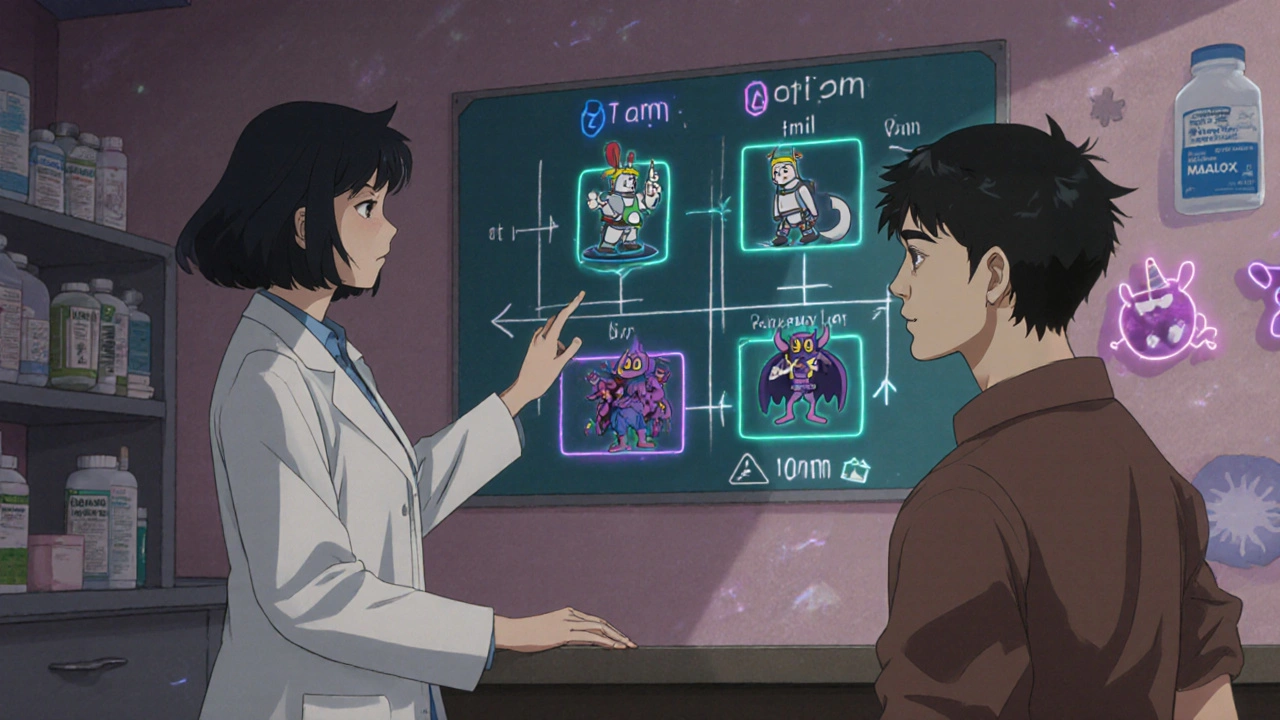Many people take antacids for heartburn or upset stomach while also on antibiotics for an infection. It seems harmless - pop a Tums with your pill. But if you do that at the same time, you might be ruining your antibiotic’s effectiveness. This isn’t a myth. It’s a well-documented, clinically significant interaction that can lead to treatment failure, longer illness, and even antibiotic resistance.
Why Antacids and Antibiotics Don’t Mix
Antacids work by neutralizing stomach acid. That’s great for relieving heartburn, but it’s a problem for certain antibiotics. Many antibiotics need a certain level of acidity to dissolve properly and be absorbed into your bloodstream. When you take an antacid, you raise the pH of your stomach, making it harder for those drugs to get absorbed. But there’s another, even stronger mechanism at play: chelation. Antacids containing aluminum, magnesium, or calcium - like Tums, Rolaids, Maalox, or Mylanta - bind directly to certain antibiotics. This creates a chemical complex that your body can’t absorb. The antibiotic passes right through you, useless. This isn’t a small issue. Studies show that taking ciprofloxacin (a common fluoroquinolone antibiotic) with an antacid can cut its absorption by up to 90%. For doxycycline, the reduction is around 30-50%. Even amoxicillin, which is less affected, still sees a 15-20% drop in absorption when taken with antacids.Which Antibiotics Are Most at Risk?
Not all antibiotics are equally affected. Some are barely impacted. Others? They’re extremely sensitive. Here’s who’s most at risk:- Fluoroquinolones - Ciprofloxacin, levofloxacin, moxifloxacin. These are the worst offenders. Even a single antacid can reduce absorption by 75-90%. The NHS and FDA both require specific timing instructions on their labels.
- Tetracyclines - Doxycycline, tetracycline. Used for acne, Lyme disease, and respiratory infections. Antacids can cut their effectiveness by half or more.
- Some others - Minocycline, and occasionally azithromycin (though the risk is lower).
Antibiotics That Are Generally Safe
The good news? Not all antibiotics are affected. If you’re on one of these, you don’t need to stress about timing:- Penicillins - Amoxicillin, ampicillin
- Cephalosporins - Cephalexin, cefdinir
- Metronidazole - Used for bacterial vaginosis, C. diff, and dental infections
- Clindamycin
How Long Should You Wait?
Timing isn’t just “take them apart.” It’s about giving your body enough space for the antibiotic to be absorbed before the antacid hits your system. Here’s what the evidence says:- Fluoroquinolones (ciprofloxacin, levofloxacin): Take the antibiotic at least 2 hours before or 4 hours after the antacid. The 4-hour window is safest for maximum absorption.
- Tetracyclines (doxycycline, tetracycline): Separate by 2-3 hours. Take the antibiotic on an empty stomach if possible - that helps absorption anyway.
- Other antibiotics (amoxicillin, etc.): A 1-2 hour gap is usually enough, but if you’re prone to stomach upset, it’s safer to space them.
- Calcium-based antacids (Tums): These bind more tightly than magnesium or aluminum ones. If you’re on a fluoroquinolone, stick to the full 4-hour separation.
Why the difference? Calcium forms the strongest chelates. Magnesium-based antacids (like Maalox) are a bit less aggressive, but still risky with ciprofloxacin. Don’t assume “milder” antacids are safe.

Real-World Consequences
This isn’t just theoretical. People are getting sick because of this. A 2021 FDA analysis of 15,000 patients found that those who took ciprofloxacin with antacids had a 22% higher rate of treatment failure for urinary tract infections. That means: more doctor visits, more antibiotics, more complications. On patient forums like Reddit, stories are common: “My UTI came back after 3 days. My pharmacist asked if I took Tums with my cipro - I did. She told me to wait 4 hours. Next dose worked perfectly.” In one case, a patient took doxycycline for acne with an antacid every night. The acne didn’t improve. After switching to taking the antibiotic 2 hours before bed and skipping the antacid until morning, their skin cleared up in 3 weeks.What If You Can’t Avoid Both?
Some people need daily acid control - GERD, ulcers, or chronic heartburn. Stopping antacids isn’t an option. What then? Switch to safer alternatives. H2 blockers like famotidine (Pepcid) and proton pump inhibitors like omeprazole (Prilosec) don’t interfere with antibiotics the same way. They don’t contain aluminum, magnesium, or calcium. They also don’t raise stomach pH as dramatically or for as long. A 2023 study showed that switching from antacids to PPIs reduced antibiotic treatment failure rates from 27% to just 9% in patients on long-term acid suppression. If you’re on a short course of antibiotics (5-7 days), your doctor might recommend skipping the antacid entirely. Use simple remedies instead: eat smaller meals, avoid spicy food, stay upright after eating.How to Get It Right - Simple Tips
You don’t need a PhD to get this right. Here’s how to make it stick:- Check your antibiotic label. If it says “avoid antacids,” take it seriously.
- Ask your pharmacist. They see this every day. They’ll tell you exactly how long to wait.
- Use a pill organizer with time slots. Put your antibiotic in one compartment, your antacid in another - with the right time between them.
- Set phone reminders. Apps like MyMedSchedule have built-in alerts for antacid-antibiotic timing.
- Write it down. If you’re on multiple meds, jot down: “Cipro at 8 AM, no antacid until 12 PM.”
Visual aids help. One Mayo Clinic study found that giving patients a simple diagram showing the “safe window” reduced timing errors by 37%.

What About Other Medications?
Antacids don’t just mess with antibiotics. They can interfere with:- Thyroid meds (levothyroxine)
- Iron supplements
- Bisphosphonates (for osteoporosis)
- Some antifungals (like ketoconazole)
Always check for interactions when starting a new drug. Your pharmacist is your best friend here.
Why This Matters Beyond Your Own Health
When antibiotics don’t work because of poor timing, it doesn’t just hurt you. It contributes to antibiotic resistance. The CDC estimates that 15% of emerging fluoroquinolone resistance may be linked to subtherapeutic doses caused by antacid interactions. That means bacteria survive, adapt, and become harder to kill - not just for you, but for everyone. This is a preventable problem. It doesn’t require new drugs or expensive tech. Just better timing.Bottom Line
Antacids and antibiotics can coexist - but only if you give them space. Don’t take them together. Don’t assume your pill is safe. Don’t guess.- For ciprofloxacin or doxycycline: wait 2-4 hours before or after antacids.
- For amoxicillin or metronidazole: 1-2 hours is fine, but spacing is still safer.
- When in doubt, ask your pharmacist - it takes 30 seconds.
Getting this right means your infection clears faster. Fewer side effects. Fewer repeat visits. And you help fight antibiotic resistance.
Can I take Tums with my antibiotic?
It depends on the antibiotic. If you’re taking ciprofloxacin, levofloxacin, or doxycycline, taking Tums at the same time can reduce the antibiotic’s effectiveness by up to 90%. Wait at least 2-4 hours after taking Tums before taking these antibiotics, or take the antibiotic 2 hours before the Tums. For antibiotics like amoxicillin or metronidazole, it’s generally safe to take them with Tums, but spacing them by 1-2 hours is still best.
What happens if I accidentally take an antacid with my antibiotic?
If you accidentally take them together once, don’t panic. One time won’t ruin your entire treatment - but it may reduce the antibiotic’s effectiveness slightly. Don’t double the next dose. Just go back to the correct timing for future doses. If you’re on a short course (like 5 days) and you missed the timing a few times, contact your doctor. You may need a longer course or a different antibiotic.
Is it okay to take antacids at night if I take my antibiotic in the morning?
Yes, if you take your antibiotic in the morning and your antacid at night, you’re likely fine - as long as there’s at least a 4-hour gap. For example, if you take ciprofloxacin at 8 AM, you can safely take Tums at 8 PM. The key is separation, not time of day. Always check the specific timing for your antibiotic.
Can I use natural remedies like baking soda instead of antacids?
No. Baking soda (sodium bicarbonate) is an antacid and can cause the same interactions. It raises stomach pH and may contain sodium, which can interfere with other medications. Don’t assume natural means safe. If you’re on antibiotics, avoid all antacids - natural or over-the-counter - unless your pharmacist says it’s okay.
Why do some doctors say this isn’t a big deal?
Some doctors downplay the risk for antibiotics like amoxicillin, where absorption drops only 15-20%. In healthy people, that small drop rarely causes treatment failure. But for fluoroquinolones and tetracyclines - especially in older adults, people with kidney issues, or those with serious infections - even a 30% drop can mean the difference between healing and a dangerous relapse. The risk varies by drug and patient. Always follow the specific guidance for your medication.








i took cipro with tums once and my UTI came back worse... my pharmacist facepalmed so hard i thought she'd break her hand. lesson learned.
so let me get this straight... we’ve got a multi-billion dollar pharma industry that tells us to pop pills like candy, but the real villain is a $3 pack of Tums? the system is a circus and we’re all clowns.
you know what’s ironic? we’re told to 'listen to our bodies' but when our body screams for antacid relief, we’re told to suffer through it because some lab-coated wizard said so. what even is health if it’s just obedience?
This post is 90% valid but the real issue is that patients aren't educated at the point of prescription. Pharmacies are understaffed, doctors are rushed, and the burden falls on the patient to read the 12-page insert they get in a tiny font. This isn't patient negligence. It's systemic failure.
The efficacy reduction percentages cited are statistically significant and clinically relevant. However, the generalization that 'all antacids' are equally problematic is misleading. Magnesium hydroxide exhibits different chelation kinetics than calcium carbonate, and the pharmacokinetic profiles of azithromycin and doxycycline are fundamentally dissimilar. Precision matters.
i used to take tums with everything like it was confetti at a parade now i know why my acne never cleared up and my UTIs kept coming back like bad exes
This is one of those quiet wins in healthcare. No new drug. No fancy tech. Just timing. A 4-hour gap changes lives. If we can teach this to everyone on antibiotics, we could cut resistance rates by a measurable margin. Small actions. Big impact.
i just took my doxy with a tums and now i feel like a dumbass but hey at least my stomach aint burnin lol 🤦♂️
nah bro this is all just big pharma scare tactics so you buy their prilosec instead. tums are natural and safe. why do you think theyve been around since 1930? lol